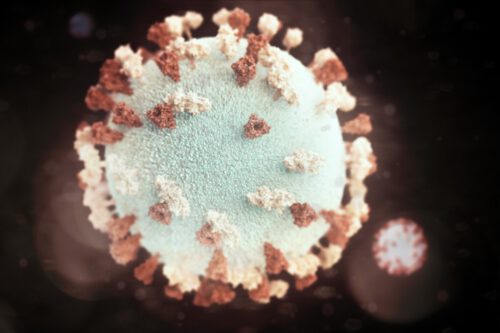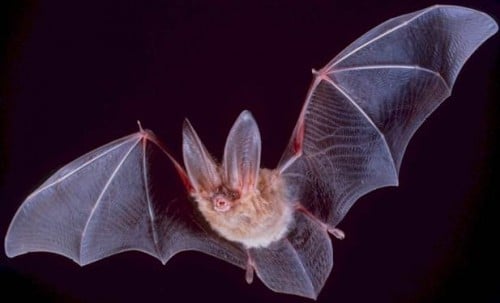An American enterprise seeks to map and identify hundreds of thousands of viruses that pass from animals to humans and that may cause the outbreak of dangerous epidemics. Will his activity prevent the next corona?
Yael Mor and Racheli Vox, Angle - Science and Environment News Agency

In 2013, two-year-old Emile Ouamuno was playing under a large tree trunk near his home in the village of Maliando in Guinea. Shortly after, he fell ill and died of the deadly disease Ebola. The tree next to which Emil was playing housed a colony of fruit bats that were apparently pushed from their previous habitat - a forest near the village that was destroyed by mining and wood products companies - to the trunk of the tree inside the village. These bats, according to the World Health Organization, are natural "hosts" of the Ebola virus. About a year after Emil's death, medical officials published a study stating that, in their estimation, the toddler is the first patient to contract the disease during its large outbreak in West Africa between 2016-2014.
The appearance of the Ebola virus, the Nipah virus and other viruses that were transferred to humans from animals prompted the establishment of the PREDICT project of the United States Agency for International Development (USAID). PREDICT researchers realized that the next virus that could threaten human health already exists, hanging around in an animal that shows no symptoms of disease, just waiting for an opportunity to make the jump to humans. As part of the project, the researchers take samples from animals from different countries in the world in order to provide a database of those viruses that have the potential to spread, before they infect humans.
Many deadly diseases, among them probably also the corona disease (COVID-19), start in a similar way: viruses that pass from animals to humans (these viruses are called zoonotic). In fact, 60 percent of the new infectious diseases originate from animals and about 72 percent of them originate from wild animals (mostly bats, rodents or monkeys) such as SARS, MERS and Ebola. Scientists estimate that there are about 800 zoonotic viruses in the world. Usually, the animals that carry them, do not get sick and do not develop symptoms, they only serve as a host body for viruses that are waiting for the opportunity to make a jump to the next species - and in our case: humans.
PREDICT sampled more than 60 countries and identified at least 931 species of new viruses, out of 145 thousand samples. Photo: cdc – unsplash
"A virus is a type of parasite that requires a host body to reproduce," explains Dr. Ron Diskin from the Department of Structural Biology at the Weizmann Institute of Science. "Viruses have a very strong evolutionary drive to enter the cell, because they need it to reproduce and spread themselves further, in fact they cannot reproduce on their own. The idea is that they have a host body in nature - one animal or several animals - where they reproduce naturally. In humans, they do not reproduce naturally, but for one reason or another, some of them can also infect humans with a zoonotic infection."

From complete blindness to a faint concept
To date, millions of people have been infected with the corona virus and hundreds of thousands have died. Since then, decision makers, senior medical officials and journalists have been trying to understand what went wrong - that is, why were many countries in the world not prepared for such an epidemic to break out? Did countries need a higher national stock of masks, ventilators, intensive care beds? Should the lockdown have started earlier?
Each of these important questions were asked after the virus broke out and killed thousands of people. But are these measures enough to eradicate an epidemic? How many viruses are there that are able to pass from an animal to humans and cause an epidemic, are we talking about hundreds, or other numbers? The PREDICT project should answer these and other questions. PREDICT was established by the American Agency for International Development (USAID) in 2009, with the aim of strengthening global capabilities for the identification and detection of zoonotic viruses with the potential to spread. The researchers in the project - epidemiologists, veterinarians and ecologists from the University of California, Davis University and the EcoHealth Alliance organization - do this by taking samples from wild animals, farm animals and also from humans. So far, PREDICT has sampled in more than 60 countries and identified at least 931 species of new viruses, out of 145 thousand samples.
"I think it would be ambitious to claim that it is possible to reach all the viruses that can infect humans - it will not happen." Dr. Ron Diskin. Photo: Weizmann Institute of Science
"I think it would be ambitious to claim that you can get to all the viruses that can infect humans - it won't happen," says Diskin. "The numbers are just too big. What PREDICT tried to do was to provide some kind of mapping that would take us out of complete blindness and into a state of weak concept. It's impossible to really know what the true number of all the viruses that are out there is, but if you do a survey, some kind of sample, you can then throw it away and try to estimate what the real pool is that exists out there in nature."
"It is important to understand, new viruses are discovered all the time, but the very large numbers of these new viruses can be attributed to families that are already familiar to us, such as the corona family to which the SARS virus belongs and of course also SARS-CoV-2 which causes the corona disease (COVID-19) ”, adds Diskin. "It doesn't mean we won't discover new families in the future, but apparently we won't discover many and the fact that we discover viruses that belong to some family is something that gives us hope that we can prepare for these viruses even if we don't know them individually."
1.67 million undiscovered viruses
In a new article published in a special issue of the journal "Ecology and Environment" dedicated to the environmental implications of the Corona epidemic, Israeli researchers warn that other zoonotic diseases are expected to appear, increase and spread more and more as long as the damage to the natural habitats of animals continues and call for measures to be taken to preserve nature - to prevent the next plague.
The strengthening of zoonotic diseases is very evident in Israel as well, and even here the phenomenon is only expected to get worse. "One of the diseases that scares us the most at the moment is West Nile Fever, a very dangerous disease, the spread of which is known to be linked to a decrease in the diversity of species in nature," says Prof. Uri Shains from the Department of Biology and Environment at Haifa-Oranim University, founder of the TiME organization and the authors of the new article . "In recent years, an increase in the number of people infected with the disease, which is transmitted by mosquito bites, has been observed in Israel."
"In recent years, new diseases have also appeared in Israel, who heard, for example, of mouse rabies a few years ago? ” says Shanes. "They are even talking about the danger of malaria returning to Israel. The fear is that new diseases will also appear, which we do not know, and will surprise us."
In the new article, written by Shines and Dr. Miri Tzlock, the various ways in which harming animals affects the strengthening of zoonotic diseases are detailed. One mechanism by which this occurs is the contact points that are created between the animals' habitats and the human environment. As humans live closer to wildlife and their interaction with them increases, so does the risk that a disease will pass from an infected animal to humans.
For example, a very strong connection was found between deforestation in the Congo Basin in Central and West Africa and the outbreak of the Ebola disease in the same area two years later, and it is possible that the reason for this is that the fruit bats, which are suspected of transmitting the disease and whose natural habitats were damaged, began to reach human settlements in search of after food
In addition to harming the animals' habitats, human hunting and trade in wild animals also contribute to the spread of zoonotic diseases. Beyond the severe damage caused to the various species and the ecosystems that rely on their existence, the contact with the animals, which in many cases includes selling them in the markets while they are alive and touching and eating their bodies and internal organs, increases the risk of the diseases that the animals carry in their bodies spreading to humans. Diseases such as Ebola, SARS, MERS, and even the AIDS virus have passed from animals to humans due to various reasons, chief among them close and unnatural contact between wild animals and humans, and as mentioned, the Corona epidemic (COVID-19) is also associated with wild animals - bats and pangolins - and may have originated in the market The wet of Wuhan where live and dead wild animals were sold in harsh sanitary conditions, although it is still difficult for researchers to say for sure if this is indeed the source of the disease.

Beyond all this, the climate crisis, which is dramatically accelerated due to human activity and which severely damages many natural environments and countless species of animals around the planet, exacerbates the risks of the spread of zoonotic diseases. This could happen, for example, through the growth created in the populations of disease-carrying insects, which thrive and extend the time and range of their activity with the help of the high temperatures that the climate crisis brings with it. These insects include the sand fly, which transmits Leishmania, and mosquitoes of various species that transmit West Nile fever, dengue fever, chikungunya, Zika and a variety of other viral diseases.
Indeed, the PREDICT researchers estimate that there are approximately 1.67 million viruses that have not yet been discovered in mammals and birds (the animals most likely to transmit viruses to humans), of which, between 631 thousand and 827 thousand viruses have the potential to infect humans. It sounds like a lot, but the good news is that the proportion of viruses capable of causing serious illness in humans is very small.
Other zoonotic diseases are expected to appear, increase and spread more and more as long as the damage to the animals' natural habitats continues. Photo: Roya Ann Miller – Unsplash
"Most viruses that are carried by animals really won't be able to pass to humans," says Diskin. "The viruses need to find the door - for them, the door is a type of molecule that is on the surface of the cells, called the 'cellular receptor' and it is actually a type of protein that they must bind to in order to successfully enter the cell. Just because they know the specific protein in animals doesn't mean the protein in the human version is good enough for them. If he is indeed good enough, then they will be able to enter the cell - but this is only the first step and it is not enough either. Then there is the very large array called the immune system and how the virus is adapted to deal with it."
According to Diskin, for this reason many viruses will not cause illness at all or will cause a very mild illness because the immune system will deal with it with great success. However, it is understood that there are viruses that the immune system is less able to deal with and then they can cause a very serious illness and even death.
What will happen to the budget?
At the end of 2019, a few weeks before the outbreak of the Corona epidemic, the funding of the PREDICT project ended. In early April 2020, the project received a funding extension of $2.6 million, so that its researchers could help identify the animal that "hosts" the COVID-19 virus. "In general, the amount of money that goes into this research is very limited," says Diskin. "I can say from my personal experience that it is difficult to obtain funding for such research. There are many bodies that finance research on diseases such as cancer, Parkinson's and Alzheimer's, mainly because it is of great interest to the population, but getting money for research on viruses is a very difficult matter."
PREDICT" is an important project, but it cannot be useful on its own, because it does not offer the solution", emphasizes Diskin. "It won't help if they say that virus X has the highest chance of the next epidemic and then we wait a few years and it will indeed cause an epidemic. More research is needed on these viruses today and drugs against them need to be developed, but there is almost no dedicated money for this, and correspondingly, the amount of basic research being done is also limited."
"I think, personally, that today it is possible to develop therapy or preventive measures against families of viruses or subgroups of viruses within a family. Even if it will not be 100 percent effective against the next virus that is discovered, it will give us a good starting point and it is much better than zero. The problem is that research on viruses like the corona, until the moment of their infection and spread, are considered esoteric. You see this reference all the time, but of course, once the epidemic broke out, all attention changed. We do not know what the next virus will be, but it is clear that there will be another epidemic in the future."
In Israel, and in various countries around the world, we are slowly and carefully getting used to the new corona routine and the easing guidelines, but what will happen when the corona also passes? Even then, will they continue funding research on potentially deadly viruses in the future? "In my opinion, as soon as the epidemic is over, they will talk about the economic cost and how much the economy needs to be restored, they will not talk about adding money to research," concludes Diskin. "On the contrary, it seems to me that there are going to be very big cuts in the research budgets because countries will only want to direct their money to rebuilding the economy."
More of the topic in Hayadan:

One response
An equally dangerous way to spread epidemics is to locate dangerous viruses in nature, just as is done in the PREDICT project, then store them in a secure laboratory to study them, and along the way try to improve and further weaponize them as a potential biological weapon. And then let them leak because "oh, it's a shame we used a Chinese defense system on the lab, next time we might use American technology".